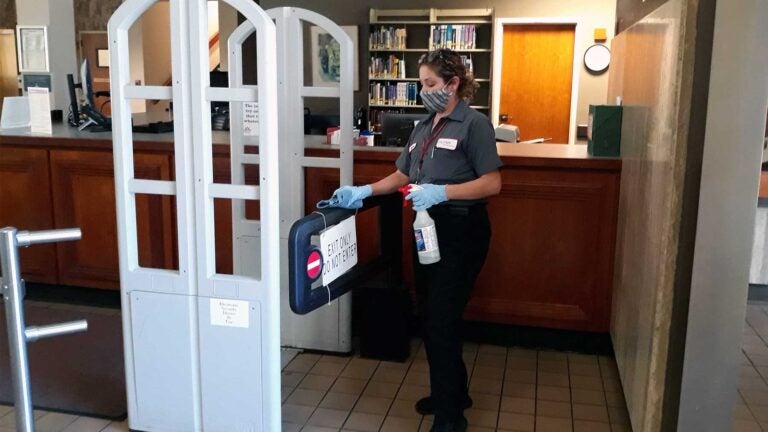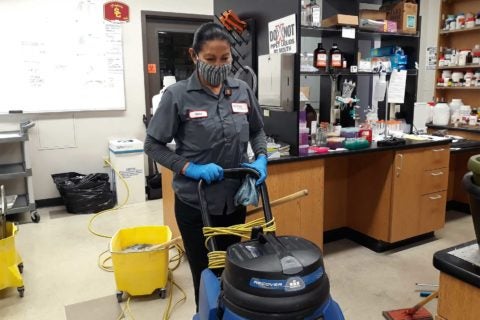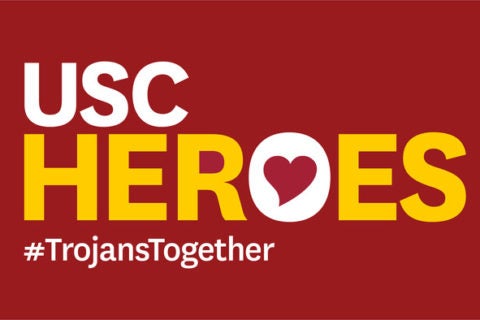
Custodial workers regularly disinfect surfaces in high-traffic areas on the USC Health Sciences Campus. (Photo/Margarita Cardenas)
USC’s custodial crew steps up cleaning efforts to reduce coronavirus danger
Intense daily disinfecting work by a dedicated team of custodians keeps essential employees and others across USC’s two main campuses safer amid the COVID-19 emergency.
For Margarita Cardenas, USC is a second home.
She started working for the university 29 years ago, at age 18, after immigrating from Mexico.
“I started as a custodian, not knowing a word of English, and I learned how to speak English here at USC,” she said. “Everything I know, I’ve learned here.”
As Cardenas rose in the ranks to her current role overseeing the custodial team at USC’s Health Sciences Campus, she has seen the bonds among her coworkers grow stronger. They feel like family. But when the coronavirus pandemic hit, that camaraderie, teamwork and sense of duty reached new heights.
“We even have a few employees who say they want to come every single day — they want to be here and helping to disinfect these buildings for their customers,” Cardenas said. “They are really on board with disinfecting and having everyone safe.”
USC’s custodians have always taken pride in a safe and clean university, but lately their work has taken on critical importance. To limit the potential transmission of COVID-19 among essential employees, students and others at the University Park and Health Sciences campuses, they rigorously clean and disinfect countless surfaces each day.
Thankfully, these cleaning specialists have critical protective gear to stay safe on campus — as they make it safe for others, said Randy Bergdahl. He helps oversee the university’s custodial work as managing contract coordinator with USC Facilities Management Services (FMS).
“I think we have really good control over the situation, and we want to keep it that way,” he said. “We are talking every day about the best strategies.”
Cleaning work emphasized at USC in response to COVID-19 pandemic
Front-line custodial workers watch after high-traffic areas like building entrances, lobbies and other shared spaces. Some workers like plumbers and electricians now also clean and disinfect, said Norm Antonini, program assistant in operations with FMS. And other employees fast-track orders for disinfecting spray, gloves and other needed supplies.

“Everybody’s really coming together, collaborating and communicating with each other in such a great way,” he said. “It’s really gone to another level. It’s nice to see how the community has come together to ensure we all do our part.”
Experts from USC Environmental Health & Safety supervise all the work, to ensure custodial workers maintain proper social distancing and use appropriate protective gear. Despite the stressful circumstances, Antonini has been impressed by their teamwork.
“A lot of the people we’re talking about have been with the university for many, many years,” he said. “I think a lot of them look forward to finishing off their careers here. There’s a big sense of pride in the university, the job they do and the contributions they make to creating a pristine environment for students and faculty to call home.”
Custodial crew’s focus on disinfection hit hyperdrive during COVID-19
On a typical day during the height of the pandemic, a reduced crew of about 45 custodial workers contracted through the company Aramark fan out across the University Park Campus before sunrise. They start at 4 a.m. and work through noon.
“They have really ramped up their efforts to go through all the buildings, all the rooms, all the laboratories to wipe things down and clean things up and disinfect on a daily basis,” Antonini said. “That’s a huge undertaking. They are working in tough conditions, but they are making it happen.”
They are a dedicated group. They’re up for the job.
Sergio Galindo
They spray down doorknobs, counters, ledges and other surfaces with disinfectant and let it sit for 10 minutes to neutralize any possible virus particles. They also check bathrooms to ensure they’re tidy and stocked with soap and paper.
In recent weeks, the University Park Campus team has returned to full staffing, with 212 employees on the job.
At the Health Sciences Campus, an in-house team of 52 custodians cleans classroom, administrative and research buildings. (Workers from contracted companies clean hospital and health care facilities.)
Sergio Galindo, custodian supervisor at the Health Sciences Campus, said many employees now focus on deep cleaning. They disinfect and scrub all surfaces, including floors. The staff also cleans restrooms and empty trash often.
Workers wear face masks and gloves while on the job. Their supervisors go over safety guidelines regularly to ensure they protect their own health and well-being.
“I think there are eight or nine steps they need to take, and those are drilled into them every day,” said Galindo, who credited workers’ willingness to comply with the guidelines. “They are a dedicated group. They’re up for the job.”
Teamwork guides cleaning efforts at USC during COVID-19 emergency
As many buildings across USC are surveyed, cleaned and stocked with necessary materials, those efforts are guided by insight from a central office: the Customer Resource Center.
As the hub of activity at FMS, the center operates 24 hours a day to handle requests related to facilities management for hundreds of buildings and thousands of customers across the university’s campuses and other properties.
These days, employees with the center work with USC’s human resources team to identify which faculty and staff members have been deemed essential to the university’s operations and still come to campus. They create color-coded maps to indicate which buildings need more attention.
“We’ve been keeping the list of occupied and unoccupied buildings updated,” said Deborah Aguilar, associate director of the center and events planning for FMS. “It’s a good way for our custodial managers to know where they should focus their time.”
High-traffic buildings get extra attention from custodial crew to maintain safety
Buildings considered critical or high profile — partly because they house many essential employees — include USC Environmental Health & Safety and USC Department of Public Safety facilities, among others. Extra caution is taken in these high-use buildings, including the USC Engemann Student Health Center.
We’re in a state of emergency, and they want to do what they can to help.
Randy Bergdahl
Bergdahl said the university hired a specialized company to conduct what is referred to as a “terminal clean” in the health center. All surfaces, including walls and ceilings, get sprayed down with a strong disinfectant, then wiped clean.
“We’re doing this every day, seven days a week,” he said.
Employees have stepped up to the increased demand, Bergdahl said, showing pride in the work they do during the pandemic.
“I have not heard or felt any negativity from anybody,” he said. “Everybody is pretty much all in, which is a cool thing. They get it. We’re in a state of emergency, and they want to do what they can to help.”




